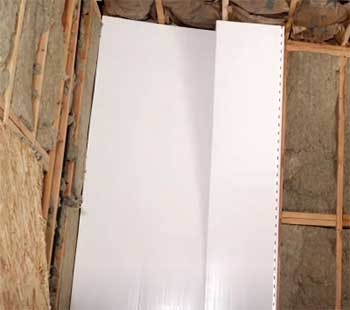If you’re looking to build or renovate your home, you’ve likely come across Trusscore and Duramax – two popular brands of structural insulated panels (SIPs). But with both claiming to be the superior product, how do you decide which is right for your project?
In this comprehensive guide, we’ll look at the key features, pros and cons, costs, and ideal applications for Trusscore and Duramax wall panels. By the end, you’ll have all the information you need to determine which brand is the better fit for your specific needs and budget.
A Brief Comparison Table
| Feature | Trusscore | Duramax |
|---|---|---|
| Core Material | EPS foam | Polyurethane foam |
| R-value per inch | R-5 | R-7 |
| Compressive Strength | Good | Excellent |
| Wind Resistance | Excellent | Excellent |
| Moisture Resistance | Excellent | Excellent |
| Cost per sq. ft. | Competitive | $0.50 – $1 less |
| Thickness Options | 4.5″ – 12″ | 4.5″ – 12.25″ |
| Warranty | 10 years | 50 years |
| Ideal Use | Cold climates, curved walls | Hot climates, multi-story |
Key Takeaways:
- Both offer structural strength, insulation, moisture resistance and fast installation
- Duramax has higher compressive strength while Trusscore has better thermal performance
- Duramax is generally more affordable on a cost per square foot basis
- Trusscore excels in cold climates and curved walls, Duramax in hot climates and multi-story buildings
- For noise reduction and supporting finishes, Duramax is preferable
- Duramax offers more thickness options and a longer thermal warranty period
- Either brand would make a smart choice depending on needs and budget
Overview of Trusscore and Duramax Wall Panels
First, let’s start with a quick primer on these two industry-leading SIP brands.
- What Is Trusscore?

Trusscore is a Canadian company that manufactures SIPs for walls, floors, and roofs. Their panels feature an expanded polystyrene (EPS) foam core sandwiched between two sheets of oriented strand board (OSB). The OSB “skins” are laminated to the EPS core using a structural adhesive.
Trusscore offers panel thicknesses ranging from 4.5” to 12” for wall applications. Their SIPs are designed to withstand extreme weather conditions and provide superior insulation. The company touts their precision engineering and claims their panels reduce air leakage and on-site labor costs.
- What Is Duramax?
Duramax is a U.S.-based manufacturer of SIPs for residential and commercial construction. Their wall panels have a solid polyurethane foam core bonded to 7/16” oriented strand board (OSB) facings.
Duramax SIPs are available in 4.5”, 6.5”, 8.25”, 10.25” and 12.25” thickness options for walls. The foam core provides structural rigidity, while the OSB skins withstand shear and axial loads. The panels are factory cut for fast assembly on the job site.
Duramax advertises their SIPs as energy efficient and resilient against moisture, mold, and pests. They also offer a 50-year thermal warranty on their wall panels.
Key Differences Between Trusscore And Duramax Wall Panels
Now that we’ve covered the basics on these two brands, let’s compare them across some key factors:
Structural Strength and Durability
When it comes to structural strength, both Trusscore and Duramax deliver excellent performance and durability:

- Wind resistance – Trusscore and Duramax panels are engineered to withstand extreme wind loads and meet the highest standards for wind uplift resistance. Both brands have been tested to withstand winds over 180 mph.
- Shear strength – The OSB facings on both panel types provide exceptional shear strength and resistance to racking. Trusscore’s laminated OSB skins give their panels slightly higher shear strength.
- Compressive strength – The foam cores in Trusscore and Duramax SIPs bear wall loads by resisting compression. Duramax’s polyurethane foam core has a higher compressive strength than Trusscore’s EPS foam.
- Insulating value – The thick foam cores of both brands deliver outstanding thermal insulation and energy efficiency. Duramax edges out Trusscore slightly with an R-value of R-7 per inch vs. Trusscore’s R-5 per inch.
- Moisture resistance – The closed-cell foam and OSB skins provide a moisture barrier and prevent rot or mold growth. Duramax offers a longer 50-year thermal warranty compared to Trusscore’s 10 years.
- Pest resistance – The foam cores deter termites and other pests. No food source = no pests!
Overall, both Trusscore and Duramax deliver excellent structural strength, insulation, and durability. Duramax has a slight edge for its higher compressive strength foam core. But both represent smart choices for resilient, energy-efficient walls.
Ease and Speed of Installation
Beyond strength and performance, an important consideration is how quickly and easily the panels install on site.
- Pre-cut design – Both Duramax and Trusscore panels come pre-cut to your project’s exact specifications, speeding installation.
- Lightweight – The SIPs weigh less than traditional stick framing materials, so they’re easier to handle and install. Trusscore’s EPS core makes their panels a bit lighter than Duramax.
- Fewer pieces – The large, continuous panels mean fewer pieces to install vs. stick framing. Complete wall sections go up faster.
- Easy connections – The OSB skins allow simple fastening with screws or nails. Panels connect together quickly with splines.
- Minimal waste – Pre-cut design and fewer pieces result in up to 75% less job site waste vs. stick framing.
When it comes to installation, Trusscore and Duramax are evenly matched. The pre-cut panels snap together easily and minimize waste. Trusscore’s lighter weight EPS core gives them a slight advantage for maneuverability. But overall, either brand delivers fast, efficient installation.
Cost Comparison
Another key consideration is cost. How do Trusscore and Duramax wall panels compare price-wise?
As with any building material, exact costs will vary by your location and the supplier you purchase from. But in general:

- Base price per square foot – Trusscore and Duramax panels are priced competitively overall. Duramax is generally $0.50 – $1.00 less per square foot.
- Thickness cost differences – With both brands, thinner panels are more affordable. Duramax offers a wider range of thicknesses at lower price points. Their 4.5” panels are the most budget friendly.
- Energy efficiency incentives – Government and utility rebates for high insulation levels may offset costs. Duramax’s higher R-value can qualify for bigger rebates.
- Labor and waste savings – Faster installation and less job site waste translate to lower labor costs. These savings help offset the base material costs for both brands.
When it comes to bottom line pricing, Duramax generally beats out Trusscore by a small margin. But Trusscore’s panels still represent a cost-competitive choice for many projects.
Ideal Applications and Uses
Trusscore and Duramax SIPs perform well in many construction applications, but each brand has ideal uses:
Trusscore Ideal Uses
- Cold climate construction – The EPS foam provides better thermal insulation in frigid temps.
- Moist climates – EPS resists moisture saturation better than polyurethane foam.
- Curved walls – Trusscore’s EPS core lends itself better to bending into curved shapes.
- Interior partition walls – Lightweight EPS core ideal for non-load bearing walls.
- Timber frame homes – Combines well with heavy timber post and beam construction.
Duramax Ideal Uses
- Hot/dry climates – Polyurethane insulates better than EPS at high temps.
- Hurricane zones – Duramax withstands extreme wind loads.
- Multi-story buildings – Higher compressive strength for heavy vertical loads.
- Noise reduction – Denser polyurethane dampens sound transmission better.
- Exterior siding – Provides continuous layer for efficient siding application.
So in summary, Trusscore may be preferable for colder climates, curved walls, and partition applications. While Duramax excels for hot climates, wind resistance, multi-story buildings, and supporting exterior finishes.
Frequently Asked Questions (FAQ)
Still have some questions about Trusscore, Duramax, and structural insulated panels? Here are answers to some common FAQs:
Yes, Trusscore is considered an excellent SIP product. Their panels provide good structural strength, insulation, and moisture resistance. Trusscore is a reputable manufacturer used widely in residential and commercial construction. They offer high quality wall panels.
Duramax SIPs are the most direct competitor to Trusscore for wall panel applications. Both offer pre-cut OSB/foam panels for whole wall construction. Other alternatives like insulated concrete forms (ICFs) or foam insulating concrete blocks share similarities with SIPs like Trusscore.
Trusscore SIPs are more expensive per square foot compared to conventional stick framing with drywall. However, they can pay for themselves through faster installation, energy savings, and labor cost reductions. And their higher upfront cost results in superior building performance.
Yes, Trusscore can be used for interior walls. Their panels work well as non-load bearing partitions between rooms. Trusscore offers specific interior wall panels that are thinner and have gypsum facing options instead of OSB. The gypsum provides an immediate paintable interior wall surface.
Closing Remarks
After comparing these two brands across structural performance, cost, installation, and ideal applications, which comes out ahead?
The answer depends on your specific project requirements and budget. But in general:
For superior thermal performance in cold climates,Trusscore is likely the better choice. The EPS foam provides maximum insulation against cold and resists moisture saturation well. Trusscore also works great for curved or non-load bearing walls.
For structural strength, wind resistance, and multi-story buildings, Duramax is likely the better pick. The higher density polyurethane foam provides excellent compressive strength for heavy vertical loads. And Duramax excels in hurricane-prone regions.
For the most affordable wall SIP solution, Duramax is the winner. While competitively priced with Trusscore, Duramax generally comes in at a lower cost per square foot. The lower price point makes them ideal for cost-conscious projects.
In many cases, the slight performance differences between the two brands are not major deciding factors. Either product will provide energy-efficient, resilient, comfortable walls. Choosing comes down to your specific needs and budget.
Hopefully this detailed comparison provides the info you need to evaluate Trusscore and Duramax and decide which structural insulated wall panel makes sense for YOUR next project!

Helpful, framing inside a 40 ft. Conex with 2X4 ( 16” centers) having spray foam for insulation, splitting the container 1/3 – 2/3 for different types storage using dual head mini split for climate control ( live in Southern Idaho temperatures range up to 105 F summer-10F winter.) going to put dehumidifiers in, concerned about mold & fungi is why I’m trying to decide. Can’t find anyone so far that carries these products, online ordering looks like. These products will work good for the walls and ceiling. Do they have a product that would work for the floor? Thank you.
Are both Trusscore and Duramax both paintable? Do they require special paint? Does paint peel off or scratch easily?